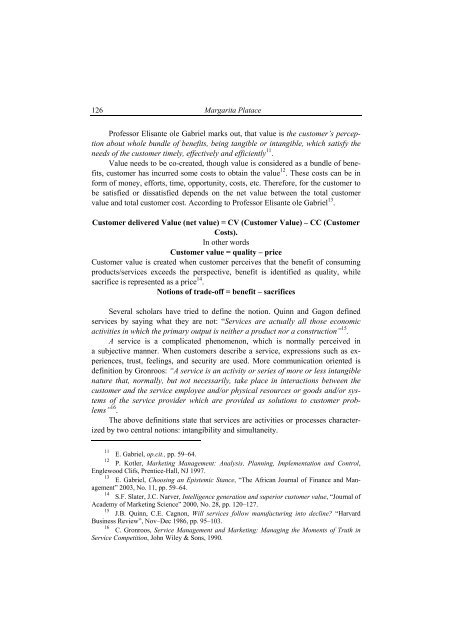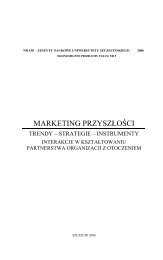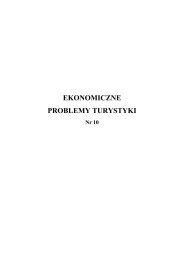Zeszyt naukowy - caÅoÅÄ - WydziaÅ ZarzÄ dzania i Ekonomiki UsÅug
Zeszyt naukowy - caÅoÅÄ - WydziaÅ ZarzÄ dzania i Ekonomiki UsÅug
Zeszyt naukowy - caÅoÅÄ - WydziaÅ ZarzÄ dzania i Ekonomiki UsÅug
Create successful ePaper yourself
Turn your PDF publications into a flip-book with our unique Google optimized e-Paper software.
126<br />
Margarita Platace<br />
Professor Elisante ole Gabriel marks out, that value is the customer’s perception<br />
about whole bundle of benefits, being tangible or intangible, which satisfy the<br />
needs of the customer timely, effectively and efficiently 11 .<br />
Value needs to be co-created, though value is considered as a bundle of benefits,<br />
customer has incurred some costs to obtain the value 12 . These costs can be in<br />
form of money, efforts, time, opportunity, costs, etc. Therefore, for the customer to<br />
be satisfied or dissatisfied depends on the net value between the total customer<br />
value and total customer cost. According to Professor Elisante ole Gabriel 13 .<br />
Customer delivered Value (net value) = CV (Customer Value) – CC (Customer<br />
Costs).<br />
In other words<br />
Customer value = quality – price<br />
Customer value is created when customer perceives that the benefit of consuming<br />
products/services exceeds the perspective, benefit is identified as quality, while<br />
sacrifice is represented as a price 14 .<br />
Notions of trade-off = benefit – sacrifices<br />
Several scholars have tried to define the notion. Quinn and Gagon defined<br />
services by saying what they are not: “Services are actually all those economic<br />
activities in which the primary output is neither a product nor a construction” 15 .<br />
A service is a complicated phenomenon, which is normally perceived in<br />
a subjective manner. When customers describe a service, expressions such as experiences,<br />
trust, feelings, and security are used. More communication oriented is<br />
definition by Gronroos: “A service is an activity or series of more or less intangible<br />
nature that, normally, but not necessarily, take place in interactions between the<br />
customer and the service employee and/or physical resources or goods and/or systems<br />
of the service provider which are provided as solutions to customer problems”<br />
16 .<br />
The above definitions state that services are activities or processes characterized<br />
by two central notions: intangibility and simultaneity.<br />
11<br />
E. Gabriel, op.cit., pp. 59–64.<br />
12<br />
P. Kotler, Marketing Management: Analysis, Planning, Implementation and Control,<br />
Englewood Clifs, Prentice-Hall, NJ 1997.<br />
13<br />
E. Gabriel, Choosing an Epistemic Stance, “The African Journal of Finance and Management”<br />
2003, No. 11, pp. 59–64.<br />
14<br />
S.F. Slater, J.C. Narver, Intelligence generation and superior customer value, “Journal of<br />
Academy of Marketing Science” 2000, No. 28, pp. 120–127.<br />
15<br />
J.B. Quinn, C.E. Cagnon, Will services follow manufacturing into decline? “Harvard<br />
Business Review”, Nov–Dec 1986, pp. 95–103.<br />
16<br />
C. Gronroos, Service Management and Marketing: Managing the Moments of Truth in<br />
Service Competition, John Wiley & Sons, 1990.

















